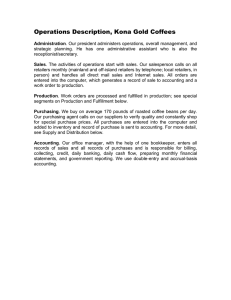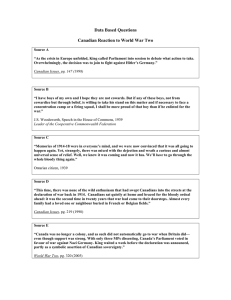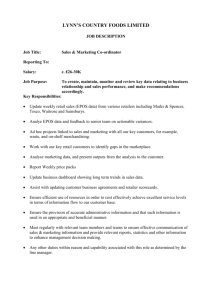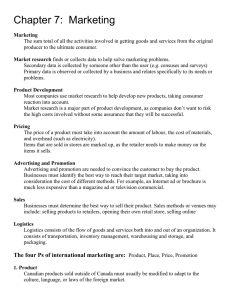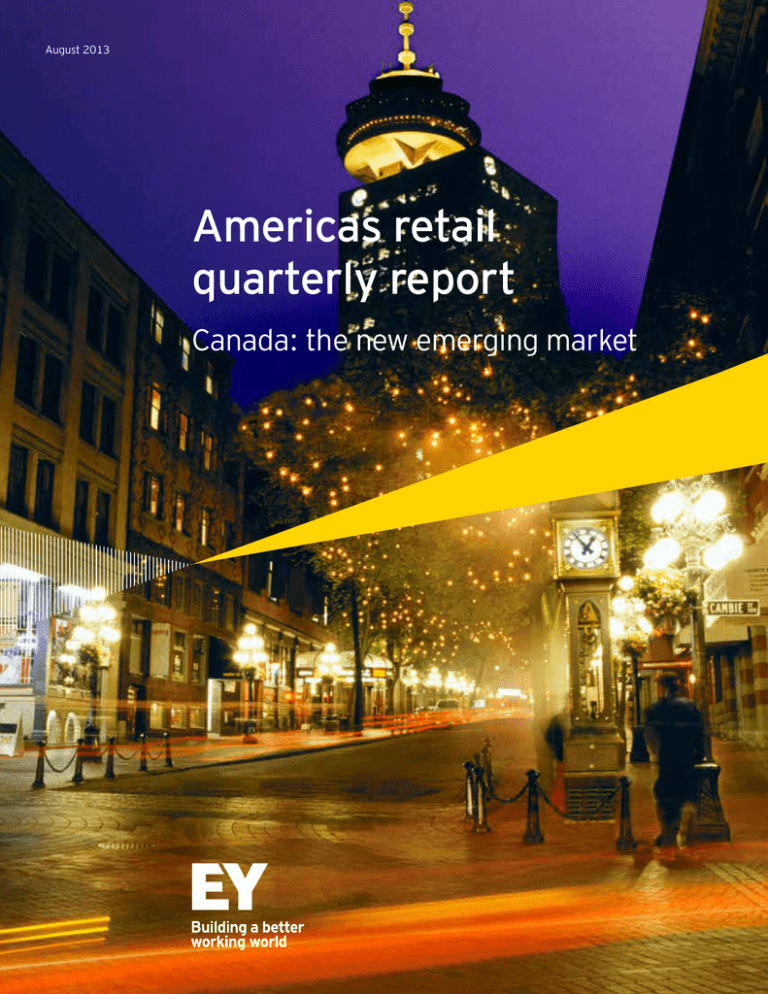
August 2013
Americas retail
quarterly report
Canada: the new emerging market
Foreword
Dan Valerio
Americas Retail Leader
Welcome to the first edition of the Americas retail quarterly report —
a quick snapshot of what we are hearing as top of mind with key
executives across our retail client base. From business to finance to
risk, the Americas retail quarterly report is a quick read that hopefully
will provide you with some interesting statistics and actionable insights.
There’s also been a loosening of the commercial real estate market, in part because of
the downsizing of some longtime local retailers. In fact, Nordstrom, which plans to open
five stores in Canada in 2014, will open three of them in former Sears Canada locations.
Target acquired some 220 leases formerly held by Zellers, and has announced plans to
open at least 125 stores in 2013.
In our first edition, Canada: the new emerging market, we explore the
state of US retailer expansion into its neighbor to the north. Canada has
long been a region of opportunity for US‑based retailers, some having
been there for years. But as post‑recession growth continues to be
hard to sustain, and overseas expansion a challenge, Canada provides
an extremely attractive alternative. So has Canada, a mature market
for sure, become an intriguing “new emerging market”? We addressed
the question with insights and information gleaned from EY subjectmatter professionals and details provided from a WSL Strategic Retail
survey — How Canada Shops, a quantitative survey conducted in 2012
simultaneously among a nationally representative sample of Canadian
(women: 1,018; men: 524) and US shoppers (women: 1,040; men:
513).
In addition, there are fewer retailers in Canada, so the competition between retailers does
not appear to be as intense. While each of the major retail sectors exist, several of these
sectors are only represented by only one or two major retailers.
But not so fast …
If US retailers want to find long-term success in Canada it will be important for them to
understand the nuances of Canadian shoppers before making the move. They don’t want
to make the mistake of treating Canada with the simplistic “10% rule,” that is, approaching
the market with mind set that everything is the same as the US except population size,
and if we execute our US strategy, sales will be 10% of the US.
Nor should they assume that having less competition means it will be easy to gain share
quickly as many of Canada’s retailers are leading class in terms of brand awareness,
execution and customer loyalty.
Why Canada? Why now?
As US companies struggle with sales and profit growth in a stalled economy, and the internet
continues to steal shares of shoppers from brick and mortar stores, many retailers are heading
to Canada in search of new opportunities.
Canada has always been a fascinating market. It’s had its own unique point of view, and for
a very long time, the majority of its retailers were Canadian. Until recently, US retailers were
cautious about moving north due to a weak Canadian dollar, smaller population and limited
commercial real estate. Today, major US retailers are seeking growth opportunities outside the
sluggish US economy and are heading to Canada. So what has changed?
US retailers in Canada
US retailers going to Canada
A sample of who’s there
•
•
•
•
•
•
Walmart
Costco
Sears
The Home Depot
Victoria’s Secret
Bath & Body Works
•
•
•
•
•
Tory Burch
J.Crew
Target
Ann Taylor
Lowe’s
• Nordstrom
• White House / Black Market
• Chico’s
Importantly, Canada was not as hard hit by the global economic crisis, and in turn, Canadian
shoppers are not struggling as much as US shoppers. A stronger Canadian dollar and relatively
robust economy have helped to open the door for US retailers.
1
Americas retail quarterly report | Canada: the new emerging market
2
How are Canadian shoppers different?
Although Canadian personal debt levels are at an all‑time high, on a relative basis,
Canadians were not as severely affected as Americans by the global economic crisis.
No surprise then that Canadians aren’t struggling as much as American shoppers: 64%
of Canadian shoppers say they can afford the “basics and more,” compared to 55% of
Americans. Additionally, Canadians aren’t feeling as constrained as Americans by rising
everyday costs on items such as food, gas and medical bills.
Factors restricting spending
Base: women
Total Canada (1,018) %
Total US (1,040) %
Rising food prices
49%
61%
Rising gas prices
Increases in medical bills
46%
67%
11%
23%
A different way of seeking value
That said, shoppers in both countries are very focused on saving money, as 72% of both
Canadians and Americans want the lowest price on most things they buy, and 62% stick to
brands and stores they can afford. However, Canadians are not as focused as Americans
on coupons and deals. Only 55% of Canadian shoppers use coupons, compared to 68% of
Americans. And Canadians who do use coupons are more likely to use electronic coupons
than search store circulars or newspapers.
Shopping strategies — how shoppers find coupons and discounts
3
Base: women
Total Canada (1,018) %
Total US (1,040) %
Check my email for offers that I receive
74%
75%
Look in newspapers/Sunday circulars
57%
79%
Pick up the circular in the store
57%
71%
Americas retail quarterly report | Canada: the new emerging market
It’s not that Canadian shoppers aren’t looking for a better deal or great value; they’re just
finding it in different ways. A higher percentage shop in dollar stores or deep-discount
grocery stores than US shoppers, so they may have less need to clip coupons.
Channels where purchased were made in last three months
Base: women
Total Canada (1,018) %
Total US (1,040) %
Supermarkets
87%
85%
Drug stores
80%
79%
Dollar stores
78%
66%
Mass merchandisers
75%
80%
Department stores
52%
62%
Warehouse clubs
49%
49%
Deep‑discount grocery
48%
28%
Internet
50%
75%
Less online shopping among Canadians, at least for now
Canadian women shop less online than their American counterparts (50% vs. 75%). It’s
not that Canadians have been slower to adopt the internet overall; they are heavy users
of online banking (for example, 73% conduct financial transactions online such as paying
bills). Canadians simply have a different mindset in terms of the role digital plays in their
shopping life. They do their homework online before they buy in a store (70% research
products online before buying), but they are less likely to purchase online. Of those who
do research online, only 58% say they then buy a product online vs. 78% of Americans.
This lower incidence of buying online may be due to the fact that until recently
Canadians had fewer online choices, that it cost more since the well-known US‑based
online retailers had to ship from US-based warehouses and the Canadian dollar bought
less of US goods. But that may not last much longer as these online players open
warehouses and distribution centers in Canada, and the Canadian dollar remains strong.
4
Implications
Canada is a growth opportunity for US retailers for many reasons, including the fact that there
are fewer shopping choices there. For many years, sales per square foot in Canada has outpaced
sales per square foot in the US, an indication of better productivity and fewer retailers north of the
border. That said, Canada has some of the greatest retailers in the world.
• Retailers and brands moving north need to look beyond their US distribution to understand where
the opportunity and the competition are if they are to be successful. Because of the limited
retail choices, brands are often sold in different channels in Canada than in the US. For example,
prestige beauty brands are sold in department stores and drug stores.
• Canadians get “value” differently. It didn’t take a recession to lead Canadians to be prudent,
cautious shoppers. They are (and were) as cautious about spending as Americans have now
become. Canadians don’t rely on coupons and sales as much as US shoppers. While that sounds
great for profitability, Canadians are still very value conscious. They just find value in different
places. For example, everyday low pricing retail is well developed in Canada: dollar stores,
deep discount grocery and warehouse clubs attract a higher share of shoppers than in the US.
Shoppers use the internet to do their homework before they shop, and they expect retailers to
send them customized offers (usually on their cell phones).
• The Canadian market is in full transformation mode. The influx of prominent US retailers has
driven Canadian retailers to respond quickly. (We are seeing major renovations being undertaken
and much more aggressive pricing.) The market will remain in flux for some time, which means
retailers there – and headed there – will need to be very flexible, responsive and firmly grounded
in delivering a unique offer if they are to succeed.
5
Americas retail quarterly report | Canada: the new emerging market
• Logistics in Canada are less obvious – Canada’s territory is larger than the US, yet has 10%
of the population. Canada has only four cities with a population greater than one million,
and the distance between two of them, Montreal and Vancouver, is over 2000 miles,
making supply chain, e-commerce logistics and distribution a challenge.
• Canada has unique income tax, sales taxes and payroll tax regimes. Careful cross‑border
tax structuring is required for any new investment in Canada.
• Canadians are accustomed to cross‑border shopping in the US and watching American
television programming and related advertising, giving US retail brands instant
name recognition.
“By and large, US retailers who have entered the Canadian market have been successful,
be it by acquisition of real estate (Walmart and Target), or organically,” says Daniel Baer,
EY Canada Retail and Consumer Products Leader.
“Although Canadian shoppers were less impacted by the recession, first quarter retail sales
were far from robust, and Canadian consumers have record‑high personal debt levels, fueled
by high real estate prices. Commonalities with US culture (language) and physical proximity
make Canada a logical stepping stone for any retailer considering international expansion. But
differences also need to be addressed to be successful, including colder weather, challenging
logistics, language (in Quebec) and income taxes, among others.”
6
EY | Assurance | Tax | Transactions | Advisory
About EY
EY is a global leader in assurance, tax, transaction and
advisory services. The insights and quality services we
deliver help build trust and confidence in the capital markets
and in economies the world over. We develop outstanding
leaders who team to deliver on our promises to all of our
stakeholders. In so doing, we play a critical role in building a
better working world for our people, for our clients and for
our communities.
EY refers to the global organization, and may refer to one or
more, of the member firms of Ernst & Young Global Limited,
each of which is a separate legal entity. Ernst & Young Global
Limited, a UK company limited by guarantee, does not
provide services to clients. For more information about our
organization, please visit ey.com.
© 2013 EYGM Limited.
All Rights Reserved.
EYG No. CF0053
BSC No. 1307-1112043
ED 0114
This material has been prepared for general informational purposes
only and is not intended to be relied upon as accounting, tax, or other
professional advice. Please refer to your advisors for specific advice.
www.ey.com

